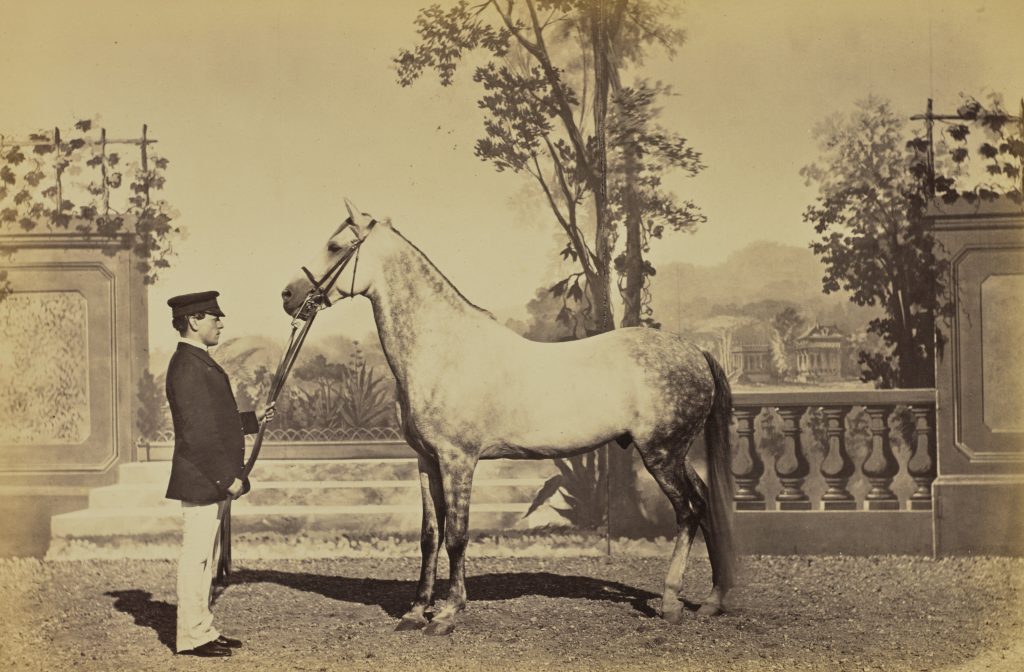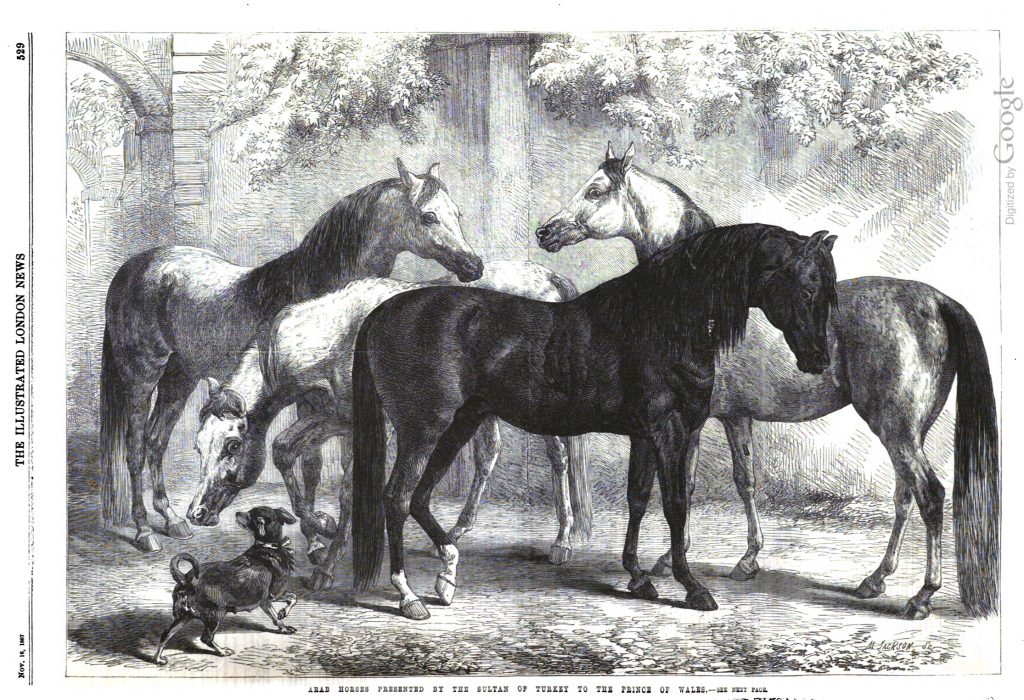The Turkish Arabians of Edward VII and Napoléon III
Quite by accident yesterday, I came across the following photograph in the Getty Museum’s collection, of an Arab stallion presented to Napoléon III by the Sultan of Turkey in 1867:

The caption reads “Aladin, étalon de pur sang arabe offert par le Sultan Abd-ul-azis à l’empereur Napoleon en 1867”. The occasion of the gift was Abdulaziz’s visit to Europe; Paris was the host city of the World’s Fair that year, and there was a significant Ottoman presence at the fair.
Aladin was not the only Arab horse presented by the Sultan to European heads of state in 1867 – he also gave horses to the British royal family, among them Kouch, sire of Gomussa, who was given to the future Edward VII. The Illustrated London News from 16 November that year mentions four of the horses by name and provides an engraving of them to boot:
The gift of the Sultan of Turkey, our late guest in London, to his Royal Highness the Prince of Wales, consisting of four noble horses of the purest Arabian breed, has been mentioned in this Journal. The Engraving on the preceding page represents these superb animals, which have been placed in the stables of his Royal Highness at Marlborough House. The horses are named Ilderim, Derwisch, Touch, and Kaplan. Whether they are up to the Prince’s weight is doubtful; but, though he may prefer one of his English hunters for his own personal use, he cannot but admire these elegant creatures of the East, and rejoice in their possession.

Touch is presumably Kouch. It is a pity that the horses are not identified in the engraving, but it is certainly more than I expected to find for Kouch!
Edit: Kouch is the bay in the foreground of the engraving. An eyewitness description of him, published in the 1868 New Sporting Magazine, runs as follows:
This is Qouch, a beautiful deep blood bay, standing 14.2 1/2 high, and an animal with quite as much, or more, the look of an English thorough-bred horse than of an Arabian. He begins with a good head and neck, although with a somewhat small eye for the sort ; has well-laid shoulders, slightly loaded at the point, with a good middle, quarters, arms, thighs, and hocks ; he is short in the cannon, but smaller than his comrades below the knee, although in this respect he would compare to advantage with some of our own breed.
Abdulaziz certainly was a busy guy when it came to gifting horses to various heads of state. I am hoping we might be able to learn more about these horses, and if they have any tangible connections to the Grant horses, *Leopard and *Linden Tree.
I am delighted to see this material surface. You two, Moira and Kate, are putting us all to shame!
I have no record of this stallion Aladin in the French SB sadly however it is not impossible he was renamed.
I have at least one more stallion recorded as given by the Sultan to the Emperor : Asbah 1857 black stallion (recorded in France in 1866).
I have 3 more stallions recorded as imported in 1866 like Asbah :
– Batbeck (more likely Balbeck, possibly a double registration since I have another chestnut Balbeck with correct spelling recorded for 1867 with the mention of him being a private import from the Massilian Mr Rogier) chestnut,
– Batma 1854 white grey
– Derviche 1859 chestnut.
None of the above fits the photo of Aladin.
As for 1867 I have 19 stallions recorded as imported :
– Light bay Abou-Mouça 1863
– Cherry bay Adjouz 1863
– Light bay Adra 1864
– Brown Arakim 1860
– Light bay Atik 1861
– “Shiny” bay Basrah 1861 (whatever this color is supposed to mean…perhaps like some Akhal-Teke a metallic tint to the coat)
– Light bay El-Bohtori 1863
– Cherry bay Farah 1860
– Cherry bay Haçan (read “Hassan”) 1861
– Hadji (no color or YoB recorded)
– Cherry bay Kadi 1862
– Dark bay Kadich 1860
– Bay Kahel 1861
– Very dark bay Katibah 1863
– Dark bay Kelb 1861
– The old grey Merkham (this one having surviving progeny in modern lines)
– Nedji (no color or YoB recorded)
– Light bay Orkal 1862
– Cherry bay Rauba 1862
So Aladin is either not recorded, or Nedji or Hadji…IMO very unlikely this is a photo of Merkham (the horse looks way too young and way to dark grey for a horse recorded as very old – which would be in the french habit probably mean over 20 years old at the time of import).
Though somehow in the French Arabian “folklore” Merkham was reputedly gifted to the Emperor by Persian Shah Nasser Ed Din…which is imo possibly incorrect. Maybe a was rather gifted by the Sultan instead.
Will let you know if i can find more 😉
Merci, Amélie! Votre recherches sont très intéressantes! Si vous trouvez quelque chose d’Aladin, je serais très heureuse de connaître. Les trois étalons Ilderim, Derwisch et Kaplan n’étaient pas enregistrés dans le General Stud Book d’Angleterre, seulement Kouch. Peut-être les dons offerts aux souverains et aux chefs d’état ont été utilisés pour l’équitation plutôt que reproduction? Cela semble être la cas pour les arabes d’Edward VII.
I am unfamiliar with the trends of the various French breeding programs, but I know that in England, not all Arabians were used to breed to other Arabians – and for that reason they were not entered. In the instance of Kouch, he was used as a breeding stud by several breeders of Arabians, and entered into the Arabian Stud Book section of the GSB posthumously. It’s possible that other Arabs brought into the country were never entered to the GSB or the Arab Stud Book, but were used to breed with polo ponies, hunters, or native British ponies, and were registered within their respective records.